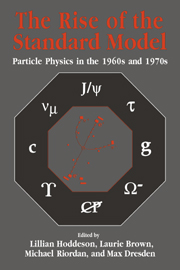Book contents
- Frontmatter
- Contents
- Contributors
- Editors' Acknowledgments
- Photographs of the Symposium
- Abbreviations and Acronyms
- Mathematical Notation
- Part One Introduction
- Part Two Quarks and Leptons
- Part Three Toward Gauge Theories
- Part Four Accelerators, Detectors, and Laboratories
- Part Five Electroweak Unification
- Part Six The Discovery of Quarks and Gluons
- 29 Early Baryon and Meson Spectroscopy Culminating in the Discovery of the Omega-Minus and Charmed Baryons
- 30 Quark Models and Quark Phenomenology
- 31 From the Nonrelativistic Quark Model to QCD and Back
- 32 Deep-Inelastic Scattering and the Discovery of Quarks
- 33 Deep-Inelastic Scattering: From Current Algebra to Partons
- 34 Hadron Jets and the Discovery of the Gluon
- Part Seven Personal Overviews
- Index
33 - Deep-Inelastic Scattering: From Current Algebra to Partons
Published online by Cambridge University Press: 03 February 2010
- Frontmatter
- Contents
- Contributors
- Editors' Acknowledgments
- Photographs of the Symposium
- Abbreviations and Acronyms
- Mathematical Notation
- Part One Introduction
- Part Two Quarks and Leptons
- Part Three Toward Gauge Theories
- Part Four Accelerators, Detectors, and Laboratories
- Part Five Electroweak Unification
- Part Six The Discovery of Quarks and Gluons
- 29 Early Baryon and Meson Spectroscopy Culminating in the Discovery of the Omega-Minus and Charmed Baryons
- 30 Quark Models and Quark Phenomenology
- 31 From the Nonrelativistic Quark Model to QCD and Back
- 32 Deep-Inelastic Scattering and the Discovery of Quarks
- 33 Deep-Inelastic Scattering: From Current Algebra to Partons
- 34 Hadron Jets and the Discovery of the Gluon
- Part Seven Personal Overviews
- Index
Summary
I begin with a disclaimer: what follows is subjective recollection, with no serious attempt of setting down an objective history. I also limit the scope of my remarks to the period roughly from 1966 to 1971. This period can in turn be divided in two parts – BF (Before Feynman) and AF (After Feynman).
Before Feynman
The climate in the beginning of this period was very different from now. David Gross has quite accurately and eloquently described it in Chapter 11, and I need not elaborate it very much here again. Field theory for the strong and weak interactions was not trusted. The emphasis was on observables, in close analogy to the Heisenberg matrix mechanics that heralded the golden age of quantum mechanics in the late 1920s. Local fields for strongly interacting particles were simply too far away from observations to be regarded as reliable descriptive elements. It was Murray Gell-Mann's great contribution to identify the totality of the matrix elements of electroweak currents between hadron states as operationally defined descriptive elements, upon which one could base a phenomenology with a lot of predictive power.
As did matrix mechanics, Gell-Mann's current algebra allowed the construction of sum rules based upon equal-time commutation relations of the electroweak currents with each other. The idea was picked up by Sergio Fubini and his collaborators, who greatly extended what Gell-Mann had started, and then by Stephen Adler and William Weisberger, who produced one of the most important and celebrated results of the period.
- Type
- Chapter
- Information
- The Rise of the Standard ModelA History of Particle Physics from 1964 to 1979, pp. 589 - 599Publisher: Cambridge University PressPrint publication year: 1997
- 4
- Cited by



